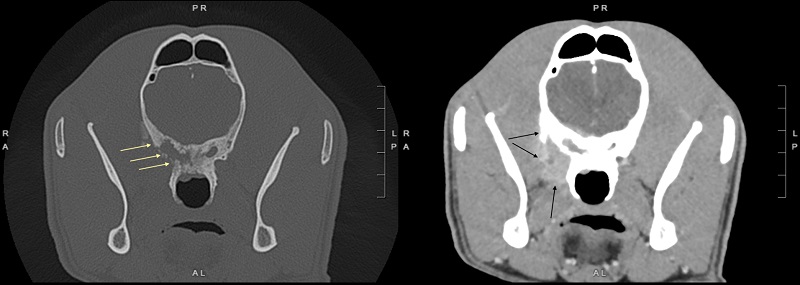Spotlight on Imaging-Guided Procedures
Clinical Connections – Summer 2023
Francisco Llabres-Diaz, Head of the Small Animal Diagnostic Imaging Service and Senior Lecturer in Veterinary Diagnostic Imaging
Diagnostic imaging has developed at an amazing pace in the last 20 years. We can now obtain hugely detailed images of the body that continuously help the Queen Mother Hospital for Animals (QMHA) offer better patient care.
The main areas of change in this period include quick in-house access to advanced imaging modalities (CT and MRI) and the quality of the images that are obtained (this applies to all modalities, with the arrival of digital radiography and the software and hardware improvements seen in ultrasound).
In addition, the Diagnostic Imaging Service at the QMHA has extensive experience in helping patients through imaging-guided procedures. Within those, ultrasound is by far the modality most frequently used and, within ultrasound-guided procedures, ultrasound-guided fine-needle aspirates are the most commonly performed. Examples would include obtaining cells from the liver and the spleen or masses.
The team is also experienced in targeting far smaller and challenging structures. It is not uncommon for colleagues in other departments to ask us to perform fine-needle aspirates of small lymph nodes in the region of 2 to 3 mm in width.
These lymph nodes can be difficult to sample, not only because of their small size, but also sometimes due to their location in the body or the fact that they are very close to vital structures like large blood vessels. Samples from orbital abscesses causing exophthalmos are another area where imaging can help not only diagnose but also treat.

Specialist training
We can teach our residents how to safely perform these procedures after a relatively short period of time. From July, the imaging team will be training five residents to become specialists in imaging. We are a large (and successful) training centre where many veterinary surgeons interested in imaging apply for further training.
We can also use ultrasound to guide the placement of needles that help the soft tissue surgeons find smaller structures that need to be removed surgically. Special localisation needles originally designed, for instance, for locating breast lesions in human medicine, are used. Once deployed, they leave a guiding wire within the patient. The surgeon can then follow that wire to the target lesion, with a significant decrease in surgical time. Foreign bodies can also be marked for removal in a similar fashion, if they cannot be simply removed under ultrasound guidance.
Although the colleagues in the anaesthesia team perform locoregional anaesthesia, rather than the imaging team, it is worth mentioning that ultrasound is used in many of those cases to guide the procedure, demonstrating the wide uses of imaging throughout the hospital.
Ultrasound is, however, not the only guiding imaging modality at the QMHA. Fluoroscopy is routinely used by our colleagues in the anaesthesia team to perform epidural injections in the pain clinic and the radiology team has been using CT to guide the sampling of deeper or more challenging lesions that may not be immediately visible with ultrasound.
A sad case where CT-guided sampling helped the owners receive confirmation that their beloved dog suffered from a tumour affecting the base of the skull demonstrated this well. We would not have been able to sample the lesion with ultrasound.
Imaging-guided sampling and therapy is a growing field. Interventional radiology is becoming more widespread in multiple veterinary centres. The imaging team is not directly involved in this field at the QMHA, but fluoroscopy is heavily used in interventional procedures.
Examples of areas where the imaging team could expand its role include the use of MRI. Here, the use of MRI-safe needles, together with the superb contrast resolution of MRI, can help in cases where MRI has been the modality of choice to investigate the clinical signs. Furthermore, imaging could become involved in the use of ablation techniques to treat lesions.
To conclude, imaging-guided sampling and interventions are going to make the future even more interesting, as veterinary medicine, following the path of human medicine, becomes more patient and disease-specific. The future is expected to introduce real changes, not only in terms of diagnosing a disease either earlier or with more certainty, but also in terms of tailoring the treatment to the specific patient.
